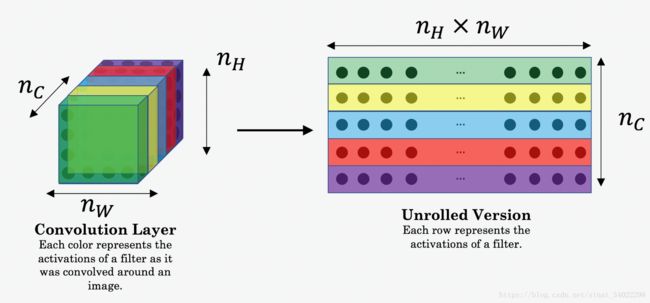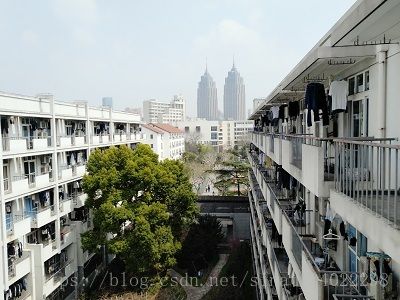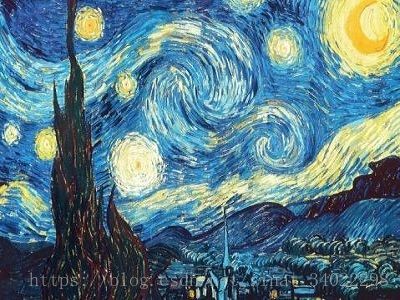《深度学习——Andrew Ng》第四课第四周编程作业_2_神经网络风格迁移
课程笔记
算法将一幅图片分为内容+风格,有了这两像,图片也就确定了,所以”生成图片主要的思想,通过两个损失函数(内容损失+风格损失)来进行迭代更新”

迁移学习总体分为三步:
- 建立内容损失函数 Jcontent(C,G) J c o n t e n t ( C , G )
- 建立风格损失函数 Jstyle(S,G) J s t y l e ( S , G )
- 加权组合起来,即总体损失函数 J(G)=αJcontent(C,G)+βJstyle(S,G) J ( G ) = α J c o n t e n t ( C , G ) + β J s t y l e ( S , G ) .
CNN是对输入的图片进行处理的神经网络,一般有卷积层、池化层、全连接层,每一层都是对图片进行像素级的运算。图片以矩阵的形式输入神经网络,在经过每一层时的输出依然时矩阵,把这个矩阵反转回去得到的图像,就是这一层对图片进行处理后得到的图像。
一个神经网络,前面几层(浅层)一般检测图片的基础特征,例如边缘和结构;后面几层(深层)一般检测图片的综合特征,例如具体的类别。
内容损失函数
我们希望“生成的”图像G具有与输入图像C相似的内容。但是选择神经网络的哪些层的输出来表示图片的内容呢,作业中使用了中间的层, 既不太浅也不太深,可以取得好的效果。 (完成此练习后,请随时返回并尝试使用不同的图层,以查看结果的变化。)
使用已经训练过的网络 VGG,输出层输入图像为C,经过VGG网络前向传播,得到 [l] [ l ] 层输出为 a[l](C) a [ l ] ( C ) ,这里用 a(C) a ( C ) 表示;同时生成一张白噪声的图片G,重复同样的操作得到 a(G) a ( G ) ,从而可以得到内容损失函数:
nH,nW n H , n W and nC n C 时指定神经网络层的输出矩阵,这里为了方便计算,做举证展开(Unrolled),如下图:

What you should remember:
- The content cost takes a hidden layer activation of the neural network, and measures how different a(C) a ( C ) and a(G) a ( G ) are.
- When we minimize the content cost later, this will help make sure G G has similar content as C C .
风格损失函数
上面的内容矩阵是直接采用指定层的输出矩阵,而风格矩阵在这里用 “Gram matrix.” 表示,也叫相关矩阵,如下图:
计算Gram Matrix首先对矩阵进行展开(Unrolled),随后再进行矩阵转置,矩阵点乘。

在线性代数中, Gram matrix表示的是矩阵中不同向量之间的相关性, G 的向量是做如下运算得到的:
矩阵对角线上的元素是 向量内积;非对角线元素是 两两不同向量内积,值的大小可以反应这两个不同向量的相关性,值越大,相关性越大。
在神经网络中,上述的进过 Unrolled 矩阵的不同向量代表同一层不同滤波器的输出,所以 Gram Matrix 对角线上的元素 Gii G i i 衡量该滤波器检测的特征值在图片中所占的比例;例如,di i i 层卷积检测垂直结构,则 Gii G i i 可以衡量该图片中垂直结构所占比例的大小。而 Gij G i j 衡量不同滤波器的相似程度。笔者认为风格函数的主要贡献在 Gram Matrix 对角线。
在有了 Gram Matrix 以后,风格损失函数定义如下:
What you should remember:
- The style of an image can be represented using the Gram matrix of a hidden layer’s activations. However, we get even better results combining this representation from multiple different layers. This is in contrast to the content representation, where usually using just a single hidden layer is sufficient.
- Minimizing the style cost will cause the image G G to follow the style of the image S S .
总体损失函数
最后,将内容损失函数和风格损失函数进行加权相加,得到总的损失函数:
有了总体损失函数,每次迭代更新的参数应该是输入白噪声图片的像素;就像是神经网络看了两幅画,找到他们的特征( [l] [ l ] 层输出图像),然后找到不同的地方(总体损失函数),去做修正(像素级),最终得到想要的结果。具体怎么更新图片像素,有待研究。
pycharm版程序
使用 tensorflow 进行训练
import os
import sys
import scipy.io
import scipy.misc
import matplotlib.pyplot as plt
from matplotlib.pyplot import imshow
from PIL import Image
from nst_utils import *
import numpy as np
import tensorflow as tf
import datetime
# GRADED FUNCTION: compute_content_cost
def compute_content_cost(a_C, a_G):
"""
Computes the content cost
Arguments:
a_C -- tensor of dimension (1, n_H, n_W, n_C), hidden layer activations representing content of the image C
a_G -- tensor of dimension (1, n_H, n_W, n_C), hidden layer activations representing content of the image G
Returns:
J_content -- scalar that you compute using equation 1 above.
"""
### START CODE HERE ###
# Retrieve dimensions from a_G (≈1 line)
m, n_H, n_W, n_C = a_G.get_shape().as_list() # 用 a_G 和 a_C 的区别?
# Reshape a_C and a_G (≈2 lines)
a_C_unrolled = tf.reshape(a_C,[n_H * n_W, n_C])
a_G_unrolled = tf.reshape(a_G,[n_H * n_W, n_C])
# compute the cost with tensorflow (≈1 line)
J_content = tf.reduce_sum(tf.square(tf.subtract(a_C_unrolled, a_G_unrolled))) / (4*n_H*n_W*n_C)
### END CODE HERE ###
return J_content
# GRADED FUNCTION: gram_matrix
def gram_matrix(A):
"""
Argument:
A -- matrix of shape (n_C, n_H*n_W)
Returns:
GA -- Gram matrix of A, of shape (n_C, n_C)
"""
### START CODE HERE ### (≈1 line)
GA = tf.matmul(A, A ,transpose_a=False, transpose_b=True) # 矩阵相乘,后面的flag表示是否对对应矩阵进行转置操作
### END CODE HERE ###
return GA
# GRADED FUNCTION: compute_layer_style_cost
def compute_layer_style_cost(a_S, a_G):
"""
Arguments:
a_S -- tensor of dimension (1, n_H, n_W, n_C), hidden layer activations representing style of the image S
a_G -- tensor of dimension (1, n_H, n_W, n_C), hidden layer activations representing style of the image G
Returns:
J_style_layer -- tensor representing a scalar value, style cost defined above by equation (2)
"""
### START CODE HERE ###
# Retrieve dimensions from a_G (≈1 line)
m, n_H, n_W, n_C = a_G.get_shape().as_list()
# Reshape the images to have them of shape (n_H*n_W, n_C) (≈2 lines)
a_S = tf.reshape(a_S, [n_W*n_H, n_C])
a_G = tf.reshape(a_G, [n_W*n_H, n_C])
# Computing gram_matrices for both images S and G (≈2 lines)
GS = gram_matrix(tf.transpose(a_S))
GG = gram_matrix(tf.transpose(a_G))
# GS = gram_matrix(a_S)
# GG = gram_matrix(a_G)
# Computing the loss (≈1 line)
J_style_layer = tf.reduce_sum(tf.square(tf.subtract(GS, GG))) / (4*tf.to_float(tf.square(n_C*n_H*n_W)))
### END CODE HERE ###
return J_style_layer
def compute_style_cost(model, STYLE_LAYERS):
"""
Computes the overall style cost from several chosen layers
Arguments:
model -- our tensorflow model
STYLE_LAYERS -- A python list containing:
- the names of the layers we would like to extract style from
- a coefficient for each of them
Returns:
J_style -- tensor representing a scalar value, style cost defined above by equation (2)
"""
# initialize the overall style cost
J_style = 0
for layer_name, coeff in STYLE_LAYERS:
# Select the output tensor of the currently selected layer
out = model[layer_name]
# Set a_S to be the hidden layer activation from the layer we have selected, by running the session on out
a_S = sess.run(out)
# Set a_G to be the hidden layer activation from same layer. Here, a_G references model[layer_name]
# and isn't evaluated yet. Later in the code, we'll assign the image G as the model input, so that
# when we run the session, this will be the activations drawn from the appropriate layer, with G as input.
a_G = out
# Compute style_cost for the current layer
J_style_layer = compute_layer_style_cost(a_S, a_G)
# Add coeff * J_style_layer of this layer to overall style cost
J_style += coeff * J_style_layer
return J_style
# GRADED FUNCTION: total_cost
def total_cost(J_content, J_style, alpha=10, beta=40):
"""
Computes the total cost function
Arguments:
J_content -- content cost coded above
J_style -- style cost coded above
alpha -- hyperparameter weighting the importance of the content cost
beta -- hyperparameter weighting the importance of the style cost
Returns:
J -- total cost as defined by the formula above.
"""
### START CODE HERE ### (≈1 line)
J = alpha * J_content + beta * J_style
### END CODE HERE ###
return J
def model_nn(sess, input_image, num_iterations=200):
# Initialize global variables (you need to run the session on the initializer)
### START CODE HERE ### (1 line)
sess.run(tf.global_variables_initializer())
### END CODE HERE ###
# Run the noisy input image (initial generated image) through the model. Use assign().
### START CODE HERE ### (1 line)
sess.run(model['input'].assign(input_image))
### END CODE HERE ###
for i in range(num_iterations):
# Run the session on the train_step to minimize the total cost
### START CODE HERE ### (1 line)
sess.run(train_step)
### END CODE HERE ###
# Compute the generated image by running the session on the current model['input']
### START CODE HERE ### (1 line)
generated_image = sess.run(model['input'])
### END CODE HERE ###
# Print every 20 iteration.
if i % 20 == 0:
Jt, Jc, Js = sess.run([J, J_content, J_style])
print("Iteration " + str(i) + " :")
print("total cost = " + str(Jt))
print("content cost = " + str(Jc))
print("style cost = " + str(Js))
# save current generated image in the "/output" directory
save_image("out1/3/" + str(i) + ".png", generated_image)
# save last generated image
save_image('out1/3/generated_image.jpg', generated_image)
return generated_image
if __name__ == '__main__':
starttime = datetime.datetime.now()
###############################################
# Reset the graph
tf.reset_default_graph()
# Start interactive session
sess = tf.InteractiveSession()
content_image = scipy.misc.imread("input/y.jpg")
content_image = reshape_and_normalize_image(content_image)
style_image = scipy.misc.imread("images/sky.jpg")
style_image = reshape_and_normalize_image(style_image)
generated_image = generate_noise_image(content_image)
plt.imshow(generated_image[0])
plt.show()
model = load_vgg_model("pretrained-model/imagenet-vgg-verydeep-19.mat")
STYLE_LAYERS = [ # style_layers 的作用
('conv1_1', 0.2),
('conv2_1', 0.2),
('conv3_1', 0.2),
('conv4_1', 0.2),
('conv5_1', 0.2)]
# Assign the content image to be the input of the VGG model.
sess.run(model['input'].assign(content_image))
# Select the output tensor of layer conv4_2
out = model['conv4_2']
# Set a_C to be the hidden layer activation from the layer we have selected
a_C = sess.run(out)
# Set a_G to be the hidden layer activation from same layer. Here, a_G references model['conv4_2']
# and isn't evaluated yet. Later in the code, we'll assign the image G as the model input, so that
# when we run the session, this will be the activations drawn from the appropriate layer, with G as input.
a_G = out
# Compute the content cost
J_content = compute_content_cost(a_C, a_G)
# Assign the input of the model to be the "style" image
sess.run(model['input'].assign(style_image))
# Compute the style cost
J_style = compute_style_cost(model, STYLE_LAYERS)
### START CODE HERE ### (1 line)
J = total_cost(J_content=J_content, J_style=J_style)
### END CODE HERE ###
# define optimizer (1 line)
optimizer = tf.train.AdamOptimizer(2.0)
# define train_step (1 line)
train_step = optimizer.minimize(J)
model_nn(sess, generated_image)
#################################################
endtime = datetime.datetime.now()
print("the running time :" + str((endtime - starttime).seconds))
print("END!")



